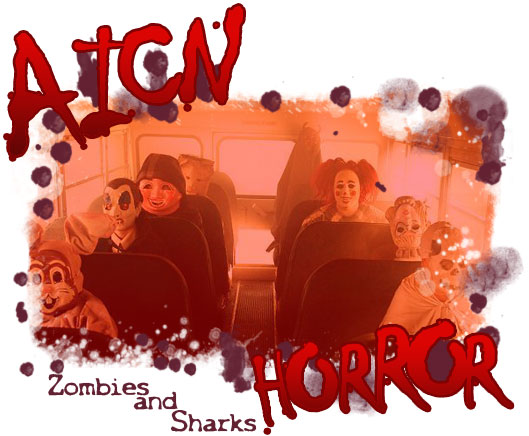
Greetings, all. Ambush Bug here with a special edition of AICN HORROR: ZOMBIES & SHARKS. Welcome to day two of my coverage of THE CALLER. Find out about my trip to Puerto Rico for the premiere, my interview with one of the stars Stephen Moyer, and a review of the film here! Today I talk with the folks behind the film. First up is writer Sergio Casci…
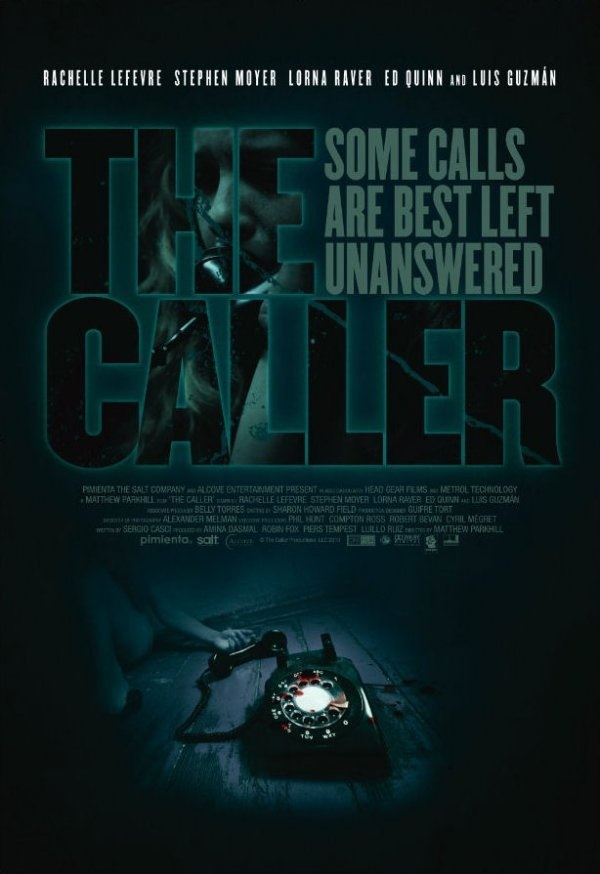 SERGIO CASCI (SC): So who else have you interviewed?
SERGIO CASCI (SC): So who else have you interviewed?AMBUSH BUG (BUG): You are my first. This is my first one. All right, so I’m here with Sergio in Puerto Rico. It’s very hot out here, and we are in the aftermath of a big hurricane that went through Puerto Rico just the other day. So other than all of that, we are here to see the premiere of THE CALLER. I saw it last night. So tell people who might not know anything about THE CALLER what the premise is.
SC: The premise is there’s this young woman and she has been through hell, you know, and she had an abusive husband and she has finally dumped him and she is living on her own. She’s got herself an apartment and she finds this beautiful old big light phone, you know the old fashioned black 50’s phones with the old fashioned dials and she thinks “Wow, that’s a beautiful thing,” so keeps it as her phone and then one day she gets a call and it’s a wrong number, or she thinks it’s a wrong number, because then the woman that was calling calls back and calls again. It eventually emerges that the woman who is calling claims to be calling from 30 years ago and then it turns out that she actually is calling from 30 years ago and not only that, she’s kind of a bit deranged and the whole thing spirals down from there and it’s pretty creepy I hope.
BUG: It definitely was. I had the pleasure of sitting next to you during the movie. What’s that like, watching the film after you have written it and it’s gone through all of this process?
SC: It’s the oddest thing. It depends on what they do with your screenplay. In this case here I was in the remarkably privileged and lucky position of having written a screenplay that I liked and that I was proud of handing it over to filmmakers who then turn it into something so much better than what I wrote. The actors, the director, the crew…they made it so much better to the extent that I’ve seen the film maybe a half a dozen times. I’ve written, rewritten, and re-rewritten a script I don’t know how many times, so I know what’s going to happen, I can pretty much speak the dialogue word for word and yet every time I watch it I still jump. There are still moments where I still feel the hair on the back of my neck rise, I get goose bumps, and I think to myself “that’s not because of what I did, that’s because of what they did”, and it’s funny, because even when we were filming I came over for a week when we were filming last time I was in Puerto Rico and there’s one scene, you might remember, the scene where Rose tells Mary that she buried something, 30 years ago of course, she has buried something near the tree in the backyard: “Go dig it up.” So Mary goes out and she digs it up and you know without giving anything away there’s something pretty gruesome inside the jar. Now I knew it was going to happen, this was not a surprise to me, and I was watching them film it and I was sitting in one of those…they had given me, very kindly, because they knew I was excited about it, you know the director’s chairs that they have? So I was like sitting in one of those which was so cool, taking photographs of myself to send to my mates saying “Guys, I’m in Puerto Rico! I’m sitting in a director’s chair. Rachelle Lefevre is seven feet away from me and she’s gorgeous!” So I’m excited, but I’m watching them film this scene, I know what’s going to happen, but the way they filmed it, the build up and Rachelle’s acting and suddenly the jar is there and she opens it and she gives out this scream and I literally fell off the stool. I don’t mean figuratively, I fell off, which for a guy with a low center of gravity, is not the easiest thing to do. I think it was at that moment that I realized I had hit the jackpot, as a screenwriter, I had hit the jackpot, because they were making…I had written what I thought was a good script and I was very proud of it, they were making a great film and I just felt so privileged to be in that position.
 BUG: So were there aspects of your story that came out during filming that were elaborated on or anything that was different than your own screenplay?
BUG: So were there aspects of your story that came out during filming that were elaborated on or anything that was different than your own screenplay? SC: In terms of the written narrative, the spoken narrative, I wouldn’t say so…there were two things, one was originally the film was set in Glasglow, Scotland and we moved it to New York. And then one of the producers said to Mathew Parkhill, you know Puerto Rico offers fantastic advantages for filmmakers, is there any way you could shoot San Juan as New York? So Mathew went to San Juan and within a few minutes he knew the answer and the answer was “Yeah, sure you can shoot San Juan as New York, but why would you want to? Why wouldn’t you shoot San Juan as San Juan?” What San Juan and Puerto Rico offers you is a whole other cultural aesthetic. It offers this sort of background to the movie, which without impinging on the narrative sort of explicitly, it gives a context to the film which brought it to a whole new level. To me it was just so amazing to come over here and the thing is I’m interested in other cultures. I have an Italian background and live in Scotland, my wife’s Australian, so I like seeing other cultures, and Puerto Rico--as well as being this beautiful island paradise, it also has fascinating and complicated stuff going on. You know, the whole business about the Santeria religion, which is this mixture of Catholic and African religions, and you know the cultural mix and the history of how people came to be here. Now as I say, this doesn’t come out in the film in any explicit way at all, but it’s there in the background if you want to look for it and it sort of informs what’s going on in a very subtle way and I think it put the film in a different bracket. We have all seen a dozen scary movies set in New York or Los Angeles or London or wherever; by setting it here in this unique place it brought a certain texture, aesthetic, and I don’t want to sound too pretentious, because it’s very easy to sound pretentious, but perhaps I’m not articulating properly where it was, it brought a feel to it which I had never dreamt of in the original screenplay, but watching the movie now I can’t imagine having shot the film anywhere else.
BUG: Yeah, I’m thinking about that scene where she goes to the graveyard and I don’t want to give too much away, but it’s such a beautiful graveyard and it’s right here in Puerto Rico and it’s got so much culture in it. I couldn’t see it going any other way.
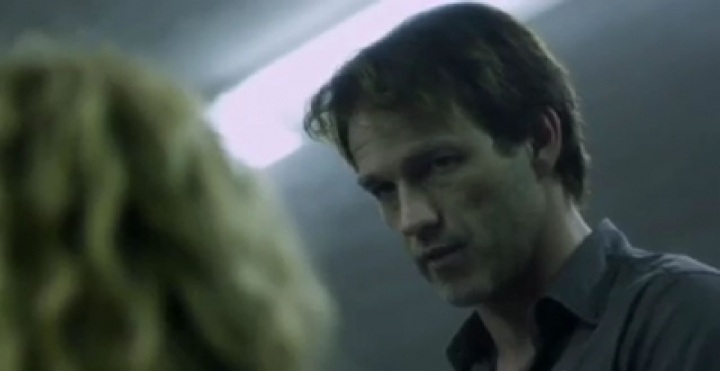 SC: You know, I was there the day they filmed that, which is lucky, because I wasn’t here for the whole shoot, but that day I was there and my wife had said “Listen, bring back lots of pictures.” She wanted pictures of Stephen Moyer, Rachelle Lefevre, and that’s what she wanted clearly, that’s what my kids wanted, I filled I don’t know how many…hundreds of pictures of these gravestones, because they’ve got these incredibly powerful statues of like three children holding hands, life-size children holding hands staring down at the grave and one of the children has his forearm missing, because it’s been snapped off by the weather or something and it’s just this…I’m not an artist with a capitol A, but even I could see the incredible visual poignancy of these statues, and to have that graveyard to film the scene…when I wrote the scene, I just wrote “A graveyard. It’s raining.” Then I watch it and it’s this blow your socks off graveyard in San Juan with this sky and the clouds and it just adds something to it and I think that’s why I’m never going to make it as a director… (laughs) I would never dream of trying to be a director. I don’t have that. I like writing stories and telling stories. I love writing dialogue and surely if you asked me to direct a film I could provide some basic coverage because I know the grammar of film, but great directors and great filmmakers have that extra thing inside their head, that vision which I cold never aspire to. So I will never make the mistake of trying to be a writer-director, because watching the work of truly great directors and filmmakers, you learn your limitations and let them do it, because at the end of the day I benefit. If folks like the film, I pretend that everything that was good about it was in the script; I mean, what are they going to do? Phone up Mathew and say, “was that really Sergio’s idea?” They’re not going to do that, they are going to believe me, so I live off the back of his success and you know…
SC: You know, I was there the day they filmed that, which is lucky, because I wasn’t here for the whole shoot, but that day I was there and my wife had said “Listen, bring back lots of pictures.” She wanted pictures of Stephen Moyer, Rachelle Lefevre, and that’s what she wanted clearly, that’s what my kids wanted, I filled I don’t know how many…hundreds of pictures of these gravestones, because they’ve got these incredibly powerful statues of like three children holding hands, life-size children holding hands staring down at the grave and one of the children has his forearm missing, because it’s been snapped off by the weather or something and it’s just this…I’m not an artist with a capitol A, but even I could see the incredible visual poignancy of these statues, and to have that graveyard to film the scene…when I wrote the scene, I just wrote “A graveyard. It’s raining.” Then I watch it and it’s this blow your socks off graveyard in San Juan with this sky and the clouds and it just adds something to it and I think that’s why I’m never going to make it as a director… (laughs) I would never dream of trying to be a director. I don’t have that. I like writing stories and telling stories. I love writing dialogue and surely if you asked me to direct a film I could provide some basic coverage because I know the grammar of film, but great directors and great filmmakers have that extra thing inside their head, that vision which I cold never aspire to. So I will never make the mistake of trying to be a writer-director, because watching the work of truly great directors and filmmakers, you learn your limitations and let them do it, because at the end of the day I benefit. If folks like the film, I pretend that everything that was good about it was in the script; I mean, what are they going to do? Phone up Mathew and say, “was that really Sergio’s idea?” They’re not going to do that, they are going to believe me, so I live off the back of his success and you know…[Both laugh]
BUG: You said last night that there were a couple of frightening moments that happened during the filming that were kind of creepy. There is a myth that a lot of horror films have creepy things that happen during…
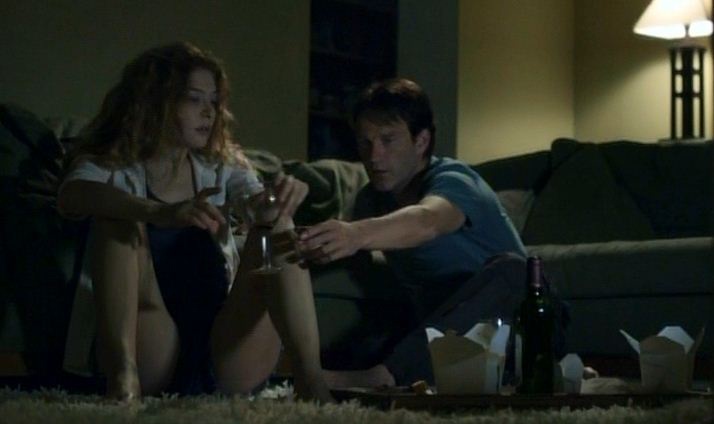 SC: Let me be straight up here. If nothing scary had happened during the filming, I would have made it up. I would have made stuff up, because you know you’ve got to have the scary stuff happen during filming, so I would have invented it. Hand on heart, I didn’t have to invent it, scary stuff happened and it started quite small with little things. For example, the baddy in the film is called Rose and it was like one of the first days of filming and they were filing in a supermarket and they moved this old fridge and we heard this clunk and we looked down and there’s this old perfume bottle, which must have been stuck behind the fridge for who knows how long and they picked it up and it said “Rose.” It was called “Rose” in and of itself not that big, but it is odd. So then they were filming…without giving anything away, you know when Mary discovers what is behind the wall? Without giving anything away, there is something behind the wall and there’s a very specific combination of things. They were dressing the set for an earlier shot and they were throwing down some copies of NATIONAL GEOGRAPHIC just to make it look as if magazines were lying around and one of the copies fell open at a page and it was a photograph and the photograph was scarily similar, virtually identical to that very particular thing that is behind the wall. The guys who were dressing the set picked it up and they said, “What does that look like? It really, really looks like it.” And also lots of small stuff were happening, not stuff that you would put in the papers, but I think it was the buildup of lots of little things and eventually some people in the crew got so spooked that I believe there was someone in the crew whose relative was a practitioner of Santeria…this is a story I heard, and they actually called her onto the set, all unofficially and all quietly and said “we don’t know if this is real or if it’s in our heads; just in case, can you ask whatever or whoever is doing this to stop?” And apparently she did and apparently it kind of did, you know? After that… I mean people seeing apparitions move across the set. There was one guy who saw an apparition move across the set and he’s a very down to earth guy and just as he saw it, this major piece of equipment exploded. I think that kind of thing makes you think. I’m not the kind of guy who believes in these things necessarily, but when they start to happen…there’s more under heaven and earth than can be perceived of in your philosophy and maybe that’s true, who knows?
SC: Let me be straight up here. If nothing scary had happened during the filming, I would have made it up. I would have made stuff up, because you know you’ve got to have the scary stuff happen during filming, so I would have invented it. Hand on heart, I didn’t have to invent it, scary stuff happened and it started quite small with little things. For example, the baddy in the film is called Rose and it was like one of the first days of filming and they were filing in a supermarket and they moved this old fridge and we heard this clunk and we looked down and there’s this old perfume bottle, which must have been stuck behind the fridge for who knows how long and they picked it up and it said “Rose.” It was called “Rose” in and of itself not that big, but it is odd. So then they were filming…without giving anything away, you know when Mary discovers what is behind the wall? Without giving anything away, there is something behind the wall and there’s a very specific combination of things. They were dressing the set for an earlier shot and they were throwing down some copies of NATIONAL GEOGRAPHIC just to make it look as if magazines were lying around and one of the copies fell open at a page and it was a photograph and the photograph was scarily similar, virtually identical to that very particular thing that is behind the wall. The guys who were dressing the set picked it up and they said, “What does that look like? It really, really looks like it.” And also lots of small stuff were happening, not stuff that you would put in the papers, but I think it was the buildup of lots of little things and eventually some people in the crew got so spooked that I believe there was someone in the crew whose relative was a practitioner of Santeria…this is a story I heard, and they actually called her onto the set, all unofficially and all quietly and said “we don’t know if this is real or if it’s in our heads; just in case, can you ask whatever or whoever is doing this to stop?” And apparently she did and apparently it kind of did, you know? After that… I mean people seeing apparitions move across the set. There was one guy who saw an apparition move across the set and he’s a very down to earth guy and just as he saw it, this major piece of equipment exploded. I think that kind of thing makes you think. I’m not the kind of guy who believes in these things necessarily, but when they start to happen…there’s more under heaven and earth than can be perceived of in your philosophy and maybe that’s true, who knows? BUG: Definitely. That sounds weird.
SC: And then to cap it all, you know talking about it, we were flying into Puerto Rico for the premiere and there’s this big fuckoff hurricane happening, which means that you know we are at the hotel and the electricity…I spent last night in this hotel with a torch and you think, you know, “Rose does not want this film to get out there. Rose is trying to stop us, but she ain’t going to manage.”
BUG: Nope, it’s not going to work.
[Both laugh]
BUG: Well I saw the film last night. It was a great film.
SC: Do you want your check now or do you want your check later?
BUG: I’ll take the check later.
[Both laugh]
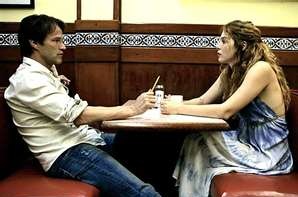 BUG: So what do you have coming up next?
BUG: So what do you have coming up next? SC: Well my wife is a novelist and I was supposed to be the famous one. I was supposed to be that, but she decided that if I could do it, she could do it. It turns out she can do it a lot better than me, but I don’t want to go into my marital shit you know, you don’t want to hear about that, but she is bloody brilliant and she wrote a book called THE DEVIL’S STAIRCASE. She’s Australian, she came over when she was young to travel the world and we met and fell in love…
BUG: And what’s her name?
SC: Helen Fitzgerald, and she wrote this book called THE DEVIL’S STAIRCASE which kind of is based on her own story. She came to London and she was in her young twenties, hooked up with some friends…I don’t know if you have ever done the “going around the world with a backpack” thing…one of the things that you realize and I’ve done it a little bit, is you meet people in the same position as you and within two days they are your best friends. It’s like they are closer to you than your family, you trust them implicitly. The fact is, it’s this artificial closeness, this accelerated friendship which makes you feel so close to them, so familiar at ease, so trusting, but actually if one of your mates back home were to say “you don’t know this person--you barely know their surname,” but you end up living with them and in the novel as it happened to Helen in real life, they sort of broke into this abandoned house, because you know squatting is this business where you move into the abandoned house and eventually you get kicked out, bit it usually takes six or eight weeks. It’s an almost accepted thing, because you just go through the legal process, as long as everybody follows the rules, nobody gets hurt and you get six weeks living rent-free in a nice house. And that’s what they did. And that’s what the character of Bronny does in THE DEVIL’S STAIRCASE, but the friend that she’s made, this girl who suddenly after two days is her best friend ever, fucks off. She disappears and Bronny’s very hurt, she thinks that she has been abandoned and is very hurt, but just assumes…what she doesn’t know is that she hadn’t buggered off, what happened was that this guy had taken Phyllis and brought her down into the bowels of the building, which is where he keeps them and he keeps them for a while until he gets a new one, so Phyllis is still alive down in the basement of this house where Bronny is living and the bad man is now planning to get Bronny next and the thing is it’s a psychological thriller. I’m a big fan of my wife’s writing. I do have to say that, but it’s also true and it’s just the way she manages to write a really brilliant novel with real three-dimensional characters who you are really invested in and care about whilst simultaneously having this terrifying narrative. I remember reading the first draft and I thought, “You do realize this is a brilliant movie?” She goes “Well, why don’t you write it?” “Oh, okay…” It was hard. Turning any book into a movie is difficult; when it’s the woman you are sleeping with every night, the mother of your children there’s a certain sense…but she’s been great and we’ve got this screenplay now. I think it’s at the state where it just needs a slight polish and we’ve got producers onboard and I think they are starting to look for directors and cast now, so I’m hoping that sooner rather than later we are going to have my next scary film out.
BUG: Great, so that seems to be a theme for you. Are you mostly interested in writing genre films like horror films and thrillers?
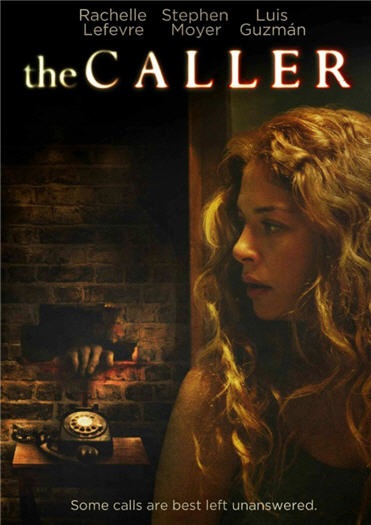 SC: I love scary stuff, yeah. I think maybe we were discussing this last night, the thing about being a horror fan is that an awful lot of the stuff you see, most of the stuff you see isn’t that good, because I think there’s a certain disdain amongst some people for horror, they see it as being a sort of cheap second rate genre which kids go and see and that’s not true. Good horror is one of the hardest things to make, because actually the ideas, the characters that you are playing with are so powerful that it’s so easy to be heavy handed. To get it right, I mean some films got it perfectly right, I mean THE SIXTH SENSE I think got it perfectly right. THE EXORCIST, I mean now THE EXORCIST almost seems like a parody of itself, because it has been parodied so much. I remember when I was a kid going to see it for the first time and I mean it robbed me. It scared me. It genuinely scared me. So to get a horror film right, the one in ten or the two in ten which are just genuinely brilliant, is such a satisfying experience that I think I’ll always be a horror fan and I’ll watch all manner of crap for the possibility of once in a while seeing just a gem. I love horror.
SC: I love scary stuff, yeah. I think maybe we were discussing this last night, the thing about being a horror fan is that an awful lot of the stuff you see, most of the stuff you see isn’t that good, because I think there’s a certain disdain amongst some people for horror, they see it as being a sort of cheap second rate genre which kids go and see and that’s not true. Good horror is one of the hardest things to make, because actually the ideas, the characters that you are playing with are so powerful that it’s so easy to be heavy handed. To get it right, I mean some films got it perfectly right, I mean THE SIXTH SENSE I think got it perfectly right. THE EXORCIST, I mean now THE EXORCIST almost seems like a parody of itself, because it has been parodied so much. I remember when I was a kid going to see it for the first time and I mean it robbed me. It scared me. It genuinely scared me. So to get a horror film right, the one in ten or the two in ten which are just genuinely brilliant, is such a satisfying experience that I think I’ll always be a horror fan and I’ll watch all manner of crap for the possibility of once in a while seeing just a gem. I love horror. BUG: Great, well good luck with THE CALLER. It was fantastic. Thanks a lot for taking the time to talk with me today.
SC: Thank you very much.
And here’s what THE CALLER’s director Mathew Parkhill had to say about the film…
 BUG: Alright, so I’m here with Mathew [Parkhill]. I saw THE CALLER yesterday and it was a fantastic film, I really liked it.
BUG: Alright, so I’m here with Mathew [Parkhill]. I saw THE CALLER yesterday and it was a fantastic film, I really liked it.MP: That’s always good to hear from Ain’t It Cool.
BUG: I think it’s really one of those smaller thrillers that…just because of the smaller scope, it makes it that much more effective. Can you tell people in your own words what the film is about?
MP: I describe it as a supernatural thriller with horror elements, rather than a straight horror movie. It’s about a character called Mary who is overcoming a difficult and abusive marriage and she moves into an apartment to start afresh and she starts getting these weird phone calls on this very old telephone that was in the apartment when she moved in from a woman called Rose. At first she thinks it’s a crank call maybe set up by her ex-husband to freak her out and then the woman starts claiming she is calling from the past. Mary is very skeptical, as you would be, and you know, but she kind of feels for this woman, because they sort of bond. The woman breaks down in tears and says that her boyfriend beats her and so they sort of bond, then it gets weirder and weirder and more intense and then when Mary tries to break contact with Rose, that’s when the shit hits the fan and all of this weird stuff starts happening and Mary realizes that Rose is controlling her life and affecting her life in the past and is having repercussions in the present, so it’s a smart supernatural thriller and I think one of the things that I loved about the script and hopefully it’s there in the movie as well, it surprises you. It’s like even with a trailer that gives a lot away, you still don’t see a lot of it coming.
BUG: So it does have a little bit of a sci-fi element with…it’s not time travel, but it has to do with string theory, I guess that’s what it’s called, but you do it in such a way that it really pares it down to its simplest form. Was that a conscious choice?
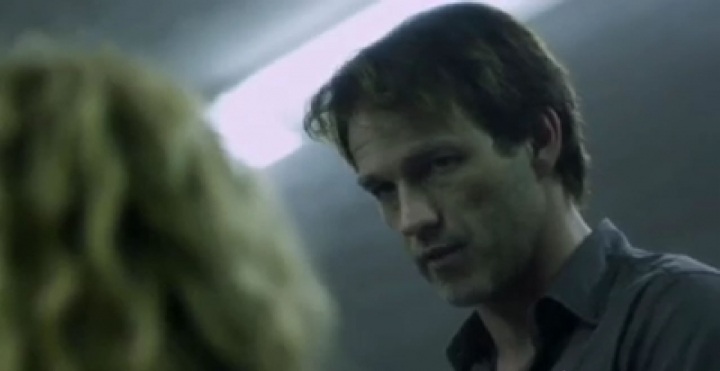 MP: It was, yeah. It’s obviously on one hand a very fantastical premise and what I always loved about the script is it never tries to explain…there’s no bolt of lightning that hits the phone and explains why it’s calling from the past, do you know what I mean? It just is and in the original script she actually discovered the phone in the old pantry. We ended up cutting that, just because it took a long time to get the story going and so now the phone is just there in the apartment, and because the apartment is weird and a bit old and kind of creepy, you sort of accept it. But yeah it was never something that I wanted to…I just wanted to establish the premise and my whole take on it was that if we could get the performances right, the atmosphere right, and create fear and create tension with a kind of a more old school ROSEMARY’S BABY kind of way, you know what I mean? I always remember Polanski saying as he was making that movie that the fear is in the atmosphere and that was what we focused on rather than the sort of time travel space time continuum thing and one of the scenes that I always loved in the movie and I loved in the script is when Steven Moyer’s character is sort of explaining…it’s the closest we come in the movie to an explanation of what’s going on, and you know, what I always loved about that is when they get to the end of that scene Rachelle’s character is like…they just laugh. She’s like “you don’t believe that, do you?” He goes “no,” and I love the fact that actually what that scene is really about is kind of a boy meets girl scene, it’s about an emotional growing together scene rather than “let’s explain the premise” scene. Do you know what I mean? And the fact that they dismiss the premise with a laugh, I always loved that in the script and I think that’s what helps it not take itself, that side of it, I didn’t want to get into. It’s not a time travel movie as such, that’s just the backdrop to the story.
MP: It was, yeah. It’s obviously on one hand a very fantastical premise and what I always loved about the script is it never tries to explain…there’s no bolt of lightning that hits the phone and explains why it’s calling from the past, do you know what I mean? It just is and in the original script she actually discovered the phone in the old pantry. We ended up cutting that, just because it took a long time to get the story going and so now the phone is just there in the apartment, and because the apartment is weird and a bit old and kind of creepy, you sort of accept it. But yeah it was never something that I wanted to…I just wanted to establish the premise and my whole take on it was that if we could get the performances right, the atmosphere right, and create fear and create tension with a kind of a more old school ROSEMARY’S BABY kind of way, you know what I mean? I always remember Polanski saying as he was making that movie that the fear is in the atmosphere and that was what we focused on rather than the sort of time travel space time continuum thing and one of the scenes that I always loved in the movie and I loved in the script is when Steven Moyer’s character is sort of explaining…it’s the closest we come in the movie to an explanation of what’s going on, and you know, what I always loved about that is when they get to the end of that scene Rachelle’s character is like…they just laugh. She’s like “you don’t believe that, do you?” He goes “no,” and I love the fact that actually what that scene is really about is kind of a boy meets girl scene, it’s about an emotional growing together scene rather than “let’s explain the premise” scene. Do you know what I mean? And the fact that they dismiss the premise with a laugh, I always loved that in the script and I think that’s what helps it not take itself, that side of it, I didn’t want to get into. It’s not a time travel movie as such, that’s just the backdrop to the story. BUG: Yeah, and I think in that same scene Stephen Moyer said something like “well, I’m a Trekkie…”
MP: That line wasn’t in the original script. I was explaining the movie to a producer friend of mine who said, “what are you doing next?” I said, well, we going to Puerto Rico and I started explaining at length the whole time travel spacetime continuum malarkey and he stopped me and said, “I’m a Trekkie, I can handle it.” I just thought “that’s such a great line, I’ll just put it in the movie.”
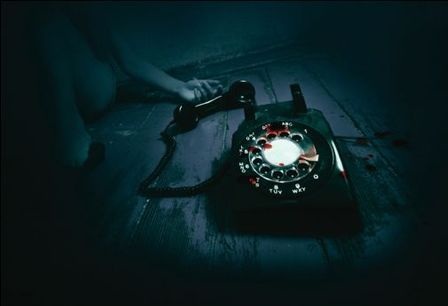 BUG: Yeah and it explains so much.
BUG: Yeah and it explains so much. MP: It’s like “you don’t need to explain.” You know, what’s great about that scene for me is it’s there if you want to take that explanation, but it’s more about the two of those characters growing closer together than it is about the explanation.
BUG: And you were originally set to film this film in New York and then it was suggested that you come down to Puerto Rico--can you talk a little bit about what the adjustments were?
MP: Well, originally it started out as a kind of financial decision, because of the tax breaks. They have a lot of stuff filmed here, like MEN WHO STARE AT GOATS was shot here, a lot of FAST AND FURIOUS 5 was shot here, THE LOSERS was shot here, a lot of stuff shoots here and they originally wanted to shoot San Juan for New York, so I came down here and looked around and I was like “You know what? You could it, if you didn’t move the camera from that building or from this building, but you know what? We’ve got such an interesting location here, such a huge place. I’ve never seen a low budget thriller set in San Juan, why don’t we change the movie, change the setting of the movie to shoot here and then we can use the texture and feel of the place?” So the changes to the script really were…it was really about changing the backstory of the characters to explain what they were doing here, which wasn’t that difficult given that there’s a big American community here, and then bringing in things that brought in the touch and the taste of this place like there’s a Santeria element in the script now and so there are certain elements in the script that came about as a result of me being here in preproduction and putting things into the script that I was learning about.
BUG: I was talking with Sergio about the graveyard scene and how powerful that was as it has the ocean in the background…
MP: I’ve never seen a graveyard like that. I mean when we first came across that…that was one of the locations, there were a couple locations that made me go “You know what? We’ve got to shoot here and set it here,” because you don’t get that kind of graveyard in New York and it is a remarkable graveyard and if you get time or something, you should go up to old San Juan, just jump in a cab. It’s an incredible place. It’s like Seville in Spain and that graveyard is just right there on the sea front.
 BUG: So as far as films, you mentioned ROSEMARY’S BABY; what else did you kind of take inspiration from?
BUG: So as far as films, you mentioned ROSEMARY’S BABY; what else did you kind of take inspiration from? MP: There were three very specific films with this one that I took a lot of inspiration from and I also talked a lot in terms of, particularly with my director of photography. The first was another Polanski film, REPULSION, in terms of the parallels of a woman in an apartment going crazy. The one thing he did a lot in that film which I really liked and kind of stole was the sounds coming through the wall and through the ceiling and that sense of growing claustrophobia. That was one, another was the GRUDGE movies, both the original and the remake, which was the same director. I just loved the tone of those films. They really had a voice. They really had a feel to them and I love the way they use sound and the third one for me was massively important was LET THE RIGHT ONE IN, the Swedish version, simply because it inspired me, because it’s such a beautiful movie and it made me realize that you could do so much with genre and I should be so lucky to make a movie that beautiful, but it made me realize…that had poetry to it. It had a poise to it and it had a beauty to it that you don’t always see in genre movies. I just read the script and I thought “God, if I could do one tenth in terms of feel and what that movie does, I’d be very happy.” So those were the three and then the last one, actually there was one other called DARK WATER, more for the visuals. Me and my DP talked a lot about that movie and watched it and stuff. So it was actually quite specific, those were the movies we thought a lot about.
BUG: Okay, so I’ve heard that there were some kind of crazy things that were happening on the set just filming the film and you hear that all of the time and I’ve heard a couple of the stories from Stephen and Sergio, but do you have any personal experiences?
MP: Well I do…do I have any personal experiences? Not just on this movie?
BUG: Either way.
 MP: Well I mean it’s funny when you hear all of these stories, especially on a horror movie, of all of these weird things happening on the set and I’m always like “that’s just a piece of marketing”, you know what I mean? But there were weird things that happened on this movie that did give me pause for thought, some of which to do with…I don’t want to talk about them, because they…we had to replace Rachelle and there was a lot of issues around that and that was tough for a lot of people, but in terms of the smaller things that happened, which I’m sure Sergio’s covered already, because he’s a great collector of these stories, but I do remember a couple of things like we were dressing the set and I’m sure he mentioned the NATIONAL GEOGRAPHIC story where the page fell open and it was the kind of thing that I wouldn’t believe, but it literally fell open at that page with these three corpses trussed up in the exact same way that our three corpses were trust up in the pantry and everyone stopped and gave a pause of thought. Sergio talks about the curse of THE CALLER like that Rose is somehow haunting the movie, even here like we come down and there’s a hurricane and the premiere gets canceled and we are all sitting without power…we are not dealing with the shit that a lot of Puerto Ricans have to deal with right now with the hurricane, but it just feels weirdly fitting, you know, but it was more like everyday was a struggle, because there were a lot of outside factors coming in and basically trying to cut us down and stop us, in fact, and from financial to right across the board and what’s interesting about that is it somehow made the fight better, more productive somehow. I’ve done projects…you don’t work on movies that go really, really well and kind of the end result maybe isn’t everything you hoped for whereas in this one it was such a fight making it and maybe I think because it was such a fight we’ve ended up with something I think everyone is very proud of, because you go through it and because…I don’t know. I’ve heard this from other directors that sometimes the movies that are the hardest to make can end of being their favorite movies that they have made.
MP: Well I mean it’s funny when you hear all of these stories, especially on a horror movie, of all of these weird things happening on the set and I’m always like “that’s just a piece of marketing”, you know what I mean? But there were weird things that happened on this movie that did give me pause for thought, some of which to do with…I don’t want to talk about them, because they…we had to replace Rachelle and there was a lot of issues around that and that was tough for a lot of people, but in terms of the smaller things that happened, which I’m sure Sergio’s covered already, because he’s a great collector of these stories, but I do remember a couple of things like we were dressing the set and I’m sure he mentioned the NATIONAL GEOGRAPHIC story where the page fell open and it was the kind of thing that I wouldn’t believe, but it literally fell open at that page with these three corpses trussed up in the exact same way that our three corpses were trust up in the pantry and everyone stopped and gave a pause of thought. Sergio talks about the curse of THE CALLER like that Rose is somehow haunting the movie, even here like we come down and there’s a hurricane and the premiere gets canceled and we are all sitting without power…we are not dealing with the shit that a lot of Puerto Ricans have to deal with right now with the hurricane, but it just feels weirdly fitting, you know, but it was more like everyday was a struggle, because there were a lot of outside factors coming in and basically trying to cut us down and stop us, in fact, and from financial to right across the board and what’s interesting about that is it somehow made the fight better, more productive somehow. I’ve done projects…you don’t work on movies that go really, really well and kind of the end result maybe isn’t everything you hoped for whereas in this one it was such a fight making it and maybe I think because it was such a fight we’ve ended up with something I think everyone is very proud of, because you go through it and because…I don’t know. I’ve heard this from other directors that sometimes the movies that are the hardest to make can end of being their favorite movies that they have made. BUG: So what was it like watching it in front of an audience last night? Had you seen it in front of an audience?
 MP: It was great. I have seen it with an audience before. The first audience I saw it with was at the Edinburgh Film Festival like the first….I mean I had seen it in front of industry audiences kind of, but the first sort of public audience was at the Edinburgh Film Festival, and it’s great. I love watching it in front of audiences. It was interesting last night, because I mean from my point of view there were issues like the print wasn’t great, the bulb in the projector was the wrong bulb, because the other bulb got blown out by the hurricane, all kinds of stuff was happening and it made the print all milky and so on a creative level I was a bit like “Argh, this doesn’t look as good as it should look” and yet I could feel in the room reel by reel the room getting stiller, the room getting more tense, and that’s a really nice feeling, you know, and even laughing at places they are supposed to laugh at and jump at the places they are supposed to jump at. It’s funny, because when I watch it with an audience, I watch it a totally different way, like I feel the audience, you know what I mean? More than I feel the movie.
MP: It was great. I have seen it with an audience before. The first audience I saw it with was at the Edinburgh Film Festival like the first….I mean I had seen it in front of industry audiences kind of, but the first sort of public audience was at the Edinburgh Film Festival, and it’s great. I love watching it in front of audiences. It was interesting last night, because I mean from my point of view there were issues like the print wasn’t great, the bulb in the projector was the wrong bulb, because the other bulb got blown out by the hurricane, all kinds of stuff was happening and it made the print all milky and so on a creative level I was a bit like “Argh, this doesn’t look as good as it should look” and yet I could feel in the room reel by reel the room getting stiller, the room getting more tense, and that’s a really nice feeling, you know, and even laughing at places they are supposed to laugh at and jump at the places they are supposed to jump at. It’s funny, because when I watch it with an audience, I watch it a totally different way, like I feel the audience, you know what I mean? More than I feel the movie. BUG: I noticed you sat in the back, is that intentionally?
MP: Yeah, because I wanted to sit next to Moyer so that I could throw popcorn at him, but also I like watching people when they are watching the movie, because as a director you can feel the room, you can feel when people are…and this is what I think about this movie, it just cranks it up, not in a kind of 0 to 60 in two seconds, it’s just moment by moment of sound by sound it just kind of cranks it up until hopefully by reel five you are really there and the tension is really tense and I felt the room was like that last night, so it was a nice experience.
BUG: I hear you are learning how to fly, is that true?
MP: I have had flying…I took a lot of flying lessons, because I want to get my pilot’s license, and then my first born daughter came along and my partner said to me “you’re not allowed to have any more flying until she’s born, because you’ve got to at least meet her.”
BUG: (laughs) Sure.
MP: And I’ve done enough hours to get my license, but in the UK you have to like eight written exams and I’ve got to do those, but yeah I didn’t enjoy the flight down here yesterday, it was bumpy as hell.
BUG: That’s what Sergio said. He said he slept through it all.
MP: I don’t know how the hell that man sleeps on planes. We took…we went like London, Philadelphia, Philadelphia Charlotte, Charlotte…Miami, I look over and the son of a bitch is just sleeping and I’m like “Argh, I want to sleep, but I can’t.” So yeah it was an adventure.
BUG: So what’s next for you?
 MP: I work as a writer as well, like I write projects for other people that are not for me to direct and so I have a job as a writer right now which a thriller, a conspiracy thriller like MICHAEL CLAYTON meets CHARIOTS OF FIRE, it’s all set around corruption in the London Olympics which I’m doing like right now as we speak and then on the directing front the next one I’m probably going to do is again totally different from THE CALLER, it’s a modern retelling of OLIVER TWIST set in London, but the take on it which I find interesting is it’s not a gang of pickpockets, all of the kids are brilliant at parkour, free running, so Fagin assembles this gang to pull off these art heists and these kids are basically like Spider-man without webs, because they can jump and scale buildings and get in through skylights and all of this shit. So my take on it is like it’s a young OCEANS ELEVEN. So I’m working on that script at the moment and that’s scheduled to shoot next spring, so if we can crack the script, which I think we are in a good place to do, I think that’s probably what I will do next.
MP: I work as a writer as well, like I write projects for other people that are not for me to direct and so I have a job as a writer right now which a thriller, a conspiracy thriller like MICHAEL CLAYTON meets CHARIOTS OF FIRE, it’s all set around corruption in the London Olympics which I’m doing like right now as we speak and then on the directing front the next one I’m probably going to do is again totally different from THE CALLER, it’s a modern retelling of OLIVER TWIST set in London, but the take on it which I find interesting is it’s not a gang of pickpockets, all of the kids are brilliant at parkour, free running, so Fagin assembles this gang to pull off these art heists and these kids are basically like Spider-man without webs, because they can jump and scale buildings and get in through skylights and all of this shit. So my take on it is like it’s a young OCEANS ELEVEN. So I’m working on that script at the moment and that’s scheduled to shoot next spring, so if we can crack the script, which I think we are in a good place to do, I think that’s probably what I will do next. BUG: Well congratulations on a great film. I watched the film last night and…
MP: I’m glad you could make it down here.
BUG: (laughs) Everybody should be congratulated, surviving these last couple of days.
MP: I’m glad that people seem to like it, because it would have been awful if they had come all the way down here and were like “What the fuck was that?”
BUG: No, not at all. Congratulations on a great film.
MP: Thanks!
BUG: THE CALLER is in limited theatrical release now and will be available on VOD later this month. Read more about my trip to Puerto Rico for the premiere, my interview with one of the stars Stephen Moyer (TRUE BLOOD), and a review of the film here!
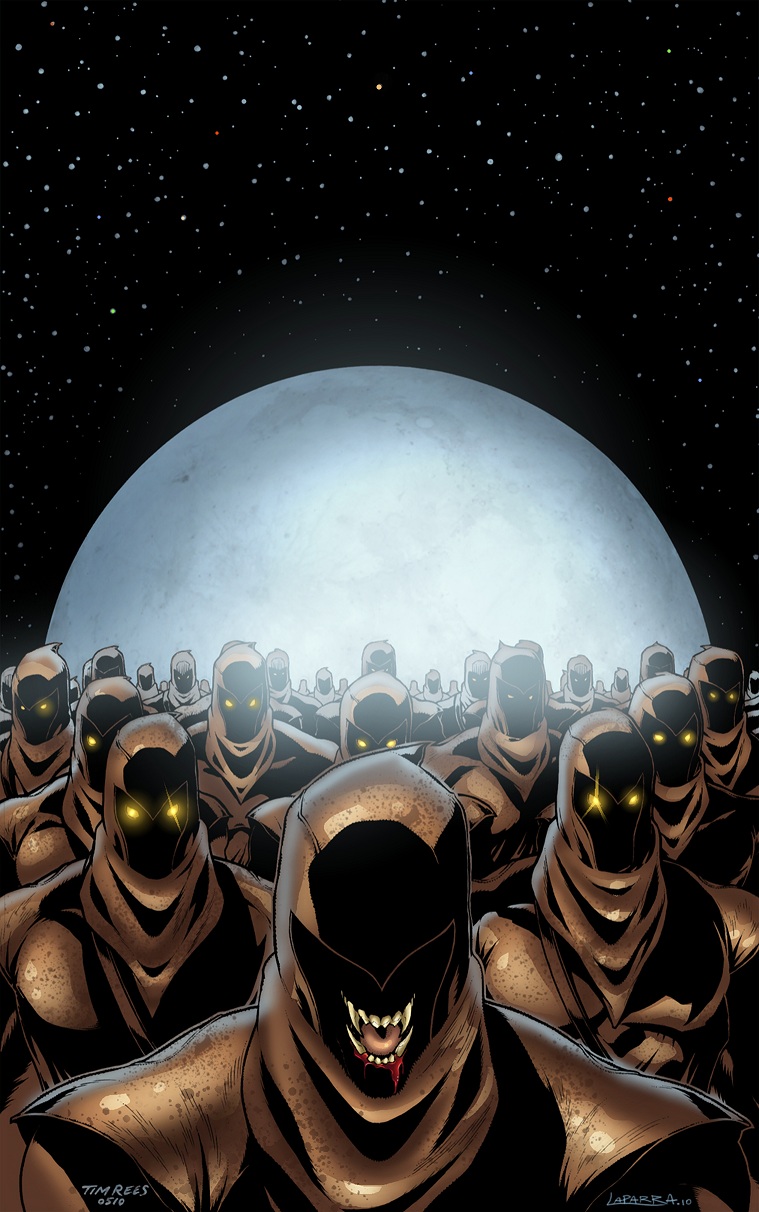 Ambush Bug is Mark L. Miller, original @$$Hole / wordslinger / reviewer / co-editor of AICN Comics for over nine years. Mark is also a regular writer for FAMOUS MONSTERS OF FILMLAND and will be releasing FAMOUS MONSTERS first ever comic book miniseries LUNA in October (co-written by Martin Fisher with art by Tim Rees) Order Code: AUG111067! Support a Bug by checking out his comics (click on the covers to purchase)!
Ambush Bug is Mark L. Miller, original @$$Hole / wordslinger / reviewer / co-editor of AICN Comics for over nine years. Mark is also a regular writer for FAMOUS MONSTERS OF FILMLAND and will be releasing FAMOUS MONSTERS first ever comic book miniseries LUNA in October (co-written by Martin Fisher with art by Tim Rees) Order Code: AUG111067! Support a Bug by checking out his comics (click on the covers to purchase)!

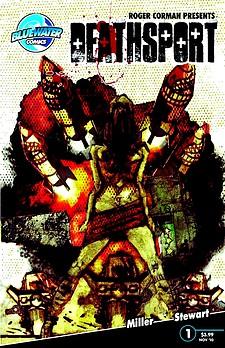
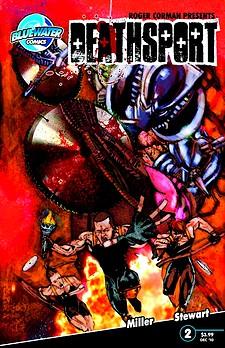
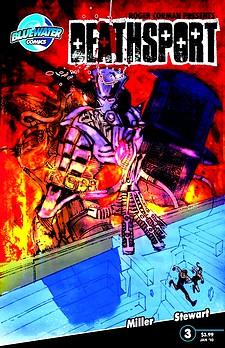
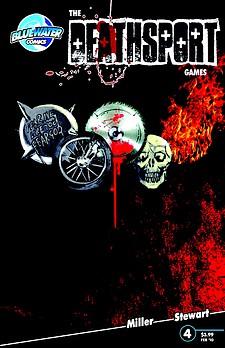
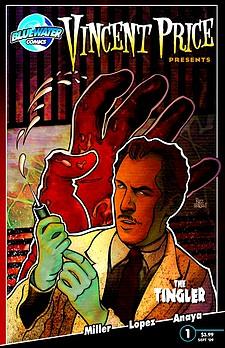
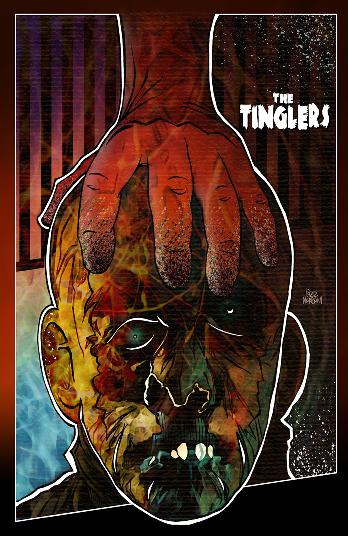

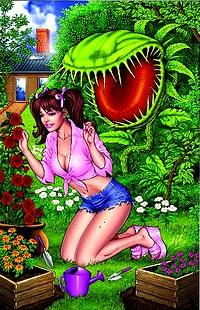


Check out NANNY & HANK’s Facebook Page
Check out THE DEATHSPORT GAMES’ Facebook Page
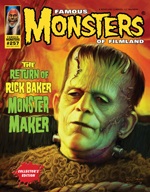
Looking for obscure, foreign, or hard to find DVDs & BluRays? Check out AH Digital: the source for international cinema!
Find more AICN HORROR including an archive of previous columns on AICN HORROR’s Facebook page!
